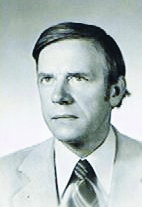Title of the work
Country of the First Edition
Country/countries of popularity
Original Language
First Edition Date
First Edition Details
Franciszek Kobryńczuk, “Adonis”, Biuletyn Północno-Wschodniej Izby Lekarsko-Weterynaryjnej [Bulletin of the North-Eastern Veterinary Chamber] 57.3 (2015): 96–98 (accessed: September 13, 2022).
ISBN
Available Onllne
Bulletin of the North-Eastern Veterinary Chamber 57.3 (2015): 96–98 (accessed: December 6, 2022).
Genre
Narrative poetry
Poetry
Target Audience
Children
Cover

We are still trying to obtain permission for posting the original cover.
Author of the Entry:
Maciej Skowera, University of Warsaw, mgskowera@uw.edu.pl
Peer-reviewer of the Entry:
Elżbieta Olechowska, University of Warsaw, elzbieta.olechowska@gmail.com
Katarzyna Marciniak, University of Warsaw, kamar@al.uw.edu.pl

Photograph courtesy of the Author.
Franciszek Kobryńczuk
, 1929 - 2016
(Author)
A veterinarian, professor of veterinary sciences specializing in animal anatomy (an authority on the anatomy of the Polish bison), writer, and poet. 1948–1950: a member of a secret youth organization active within the post-WW2 underground connected to Armia Krajowa [Home Army], banned by the Communist regime; in 1950 he was sentenced to a 10-year prison term for this activity; fully exonerated after the fall of Communism. Graduated from the Faculty of Veterinary Medicine of the Warsaw University of Life Sciences (SGGW); from 1994 to 2000 Head of the Department of Animal Anatomy at the same University. Debuted as an author for children in 1958 with a short poem Sowa [Owl], published in children’s magazine “Miś”; contributor to several other magazines for children and young adults, such as “Świerszczyk,” “Płomyk,” “Płomyczek,” and “Mały Apostoł”; author of about 30 books for children, young adults and adults; a former member of the Polish Writers’ Union; now his poems can be found most of all online. The page ewa.bicom.pl/wierszedzieci run by a Kobryńczuk’s admirer, Ewa Białek, functions as the official website for Kobryńczuk’s poems for children.
Source:
Materials kindly provided by the Author.
Bio prepared by Maciej Skowera, University of Warsaw, mgskowera@gmail.com
Summary
When Adonis becomes an orphan, Aphrodite becomes his guardian and soon begins to love him. The goddess comes up with the idea that the beautiful boy, to avoid catching a cold, should go down to Hades with Persephone for the winter. When Persephone emerges from the Underworld in the spring, it turns out that she has also fallen in love with Adonis and does not want to give him to Aphrodite. Zeus settles the dispute: Adonis will spend one-third of the year with Aphrodite, one-third – with Persephone, and the last part – alone, resting away from the two goddesses. However, it soon turns out that Artemis, too, has fallen in love with Adonis and is jealous of him. One morning, she sends a boar at the boy, which mortally wounds him. A flower grows from his blood and dead body – a red anemone that is always reborn in the spring, just as Adonis was to return from Persephone to Aphrodite. (White roses also grew where the boy died. When Aphrodite tried to run to his aid, she injured her foot against one of them, dyeing the flowers red – which is why the red rose becomes a symbol of love.)
Analysis
Using the metamorphosis motif, the poem explains the relationship between Aphrodite, the goddess of love, and the various flowers with which she was associated in ancient Greece. Importantly, Adonis’ perspective is not shown in this piece; three female goddesses are designated as acting figures, and their decisions (and partly Zeus’) determine the boy’s fate. Therefore, Franciszek Kobryńczuk allocates specific stanzas to successive goddesses. At the end of the poem, there is an encouragement to give somebody red roses – symbols of love – if one is sure of the feeling. Interestingly, the poem forms a ‘floral triptych’ with two other pieces dedicated to Hyacinth and Narcissus.
Further Reading
Nosek, Anna, W przestrzeniach universum i regio. Wiersze dla dzieci współczesnych pisarzy regionu podlaskiego – interpretacje [In the Spaces of universum and regio: Poems for Children by Contemporary Writers of the Podlasie Region – Interpretations], Białystok: Wydawnictwo Uniwersytetu w Białymstoku, 2015.


